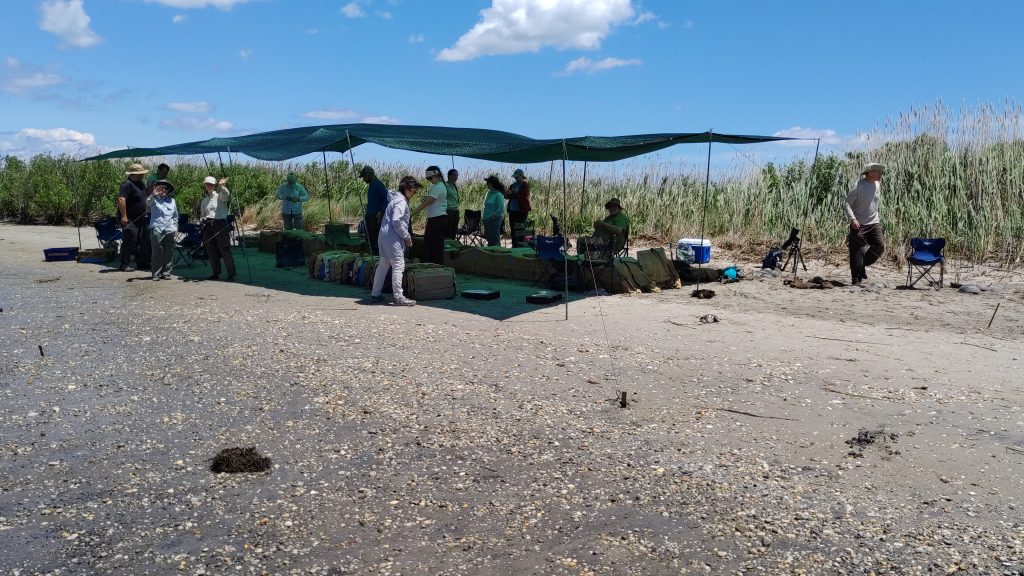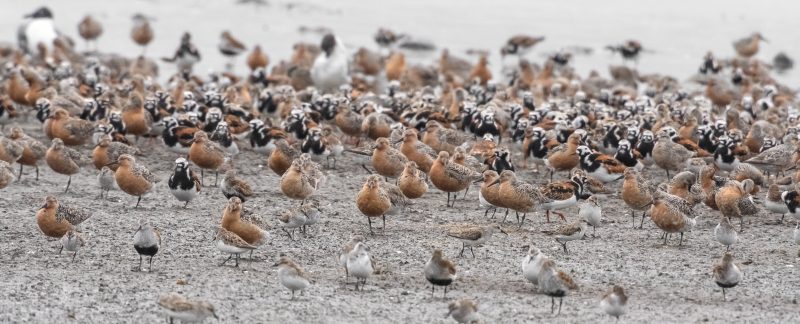Our third week started with the next aerial count; this one was setting out from Cape May at 08:00 hrs. We were all on site on time and got some counts done before the plane came over at the expected time. Strangely, the plane didn’t do the second pass over Mispillion, which is the usual protocol. There were good numbers of Knot on Back Beach, so the Mispillion count team stayed out to resight there, as did the Brock team, while Cathy and Lys went out to trap the PIPLs at Fowler’s. With relatively good resighting in Mispillion through the day there were three boat trips, with the last crew leaving when it started to get dark – the rest of us ate our frittata before they got back!
On Friday we were back trying to catch in Mispillion and had up to 58 Knot in the area but weren’t able to catch as there were so many Semis in the air all the time. We deployed Rob as a ‘slug’ twinkle (keep low on the ground) and while twinkling, he was told that slugs don’t hold their heads up! He was then told to be a super-powered slug and move sideways very quickly while Katharine was deployed as a second slug – but all to no avail. We considered resetting but decided to give up and leave a group of resighters out – of course they later reported that we could have reset and made a catch. Saturday was departure day for three of the WWRG team and so we decided to do the traditional thing and ‘catch and run’. Back in Mispillion again, with a change to the catching area to reflect what the resighters had seen yesterday. It was difficult again, with very small windows of opportunity to catch – we got a great catch this time, but with fewer Knot than expected. Rob, Guy and Katharine were all in one processing team, with a couple of other people, so it didn’t disrupt too many processes when they had to leave – sadly well before we had finished processing – but they got to the airport and then home without incident.
Species N R T
SESA 101 2 103
DUNL 11 0 11
RUTU 221 13 234
REKN 19 0 19
SBDO 12 0 12
SAND 20 1 21
WRSA 4 0 4
TOTAL 388 16 404

Back in the harbour on Sunday and there were plenty of Turnstone, but only about 200 Knot and SO many Semis that it was difficult to see Knot and Turnstone legs for Semis, which are just the right height to block your view. Other sites were surveyed, all the sorting out after the catch was done and data inputting and checking were a priority. With few Knot caught on Saturday, we decided to try another catch on Monday, to get more weight data.
The plan on Monday was to set early when the birds weren’t on Back Beach to see what we were doing – the set team left at 06:15 hrs. That didn’t work out and we had to move the net, eventually caching at about 12:15 hrs. There were a lot of Semis again making it difficult to make a catch of the study species and, with Rob (our twinkling ‘slug’) having left, we deployed Paul in the Jon Boat to be a ‘seaslug’ twinkler to gently encourage more of the study species into the catching area. The Jon Boat wasn’t entirely happy, and Paul ended up first paddling it and then getting out (up to his chest in the sea) and gently guiding it to the shore. It worked and we made a catch, but again with fewer Knot than we would have liked. As we were leaving the beach with gear in the Skiff one of the team decided to get over the side to help without realising how deep the water was – she slipped and ended up wet up to her armpits. Her return to the boat was also less than elegant, consisting of a forward roll on board and getting stuck in the space between the gear and the seat –but she still enjoyed the day!
Species N R T
SESA 173 1 174
DUNL 1 0 1
RUTU 46 4 50
REKN 7 0 7
SAND 5 0 5
TOTAL 232 5 238
With the end of the season looming on Tuesday, we fitted in another round of surveys and worked hard to get the data inputting up-to-date and checked. Despite having relatively few sightings this year (the REKNs were late in), with a smaller team we couldn’t get as much checking done as usual and didn’t find the time to wash feathers. We thought we had finished catching until Nigel found a lot of Sanderling on Back East and he and Richard hatched a plan for Wednesday …
We headed off out again for a (limited-time) catch attempt on Back East near Mid North with one net, fairly high up the beach where birds were running up to on Tuesday. We had both Turnstone and Sanderling around but, although they would work their way up to the far edge of the area, very few ever walked in. We set a deadline of 10:00 hrs to catch and only went a short time over that as it was looking vaguely possible at 10:00 hrs. When we went out to pick up, we noticed that the sand changed colour at the far bend of the catching area, beyond which it was lighter and more scuffed and may have been a better feeding area or made the net more visible. Back to Penguin Manor and the Brit house to start to sort out, clear up and pack, with a departure time (with a clean house) of 10:00 hrs on Thursday.
Our last day started bright and early to finish packing and get everything in the house clean and sorted. We had brought quite a lot of things up from Penguin Manor, as the house didn’t have big pots and pans and had relatively little cutlery and sharp(ish) knives; we had also borrowed rugs to catch sand and brought in shelving for food and gear. Several pick-up truck loads later we had everything back at Penguin Manor and could get all our stuff out and get cleaned through – with everything looking good by about 09:30 hrs when we left. We had a quick look in the Harbour (~800 Semis) before setting off for Baltimore where we visited the National Aquarium for a great behind-the-scenes tour with Deb Dial. The first team had recommended an airside Mexican restaurant for a meal before flying and, after a bit of messaging with them, we found it and indulged in cocktails (also recommended!). The flight back was uneventful, although the midnight switch of planes at Keflavik was a bit brutal, and we arrived back to incredibly green English countryside.
Another field season done and (as always) a slightly strange one – living in two houses adds to the complexity of the work, as we had to drive up to Penguin Manor to sort cannon-netting gear or to input data (which are harder to keep track of – but not as hard as keeping track of the radios – especially the one Richard managed to drop into the water at the Marina). With Covid in mind and with 12 people living in one house (plus tent city), we kept the ‘Brit house’ just for those of us staying there. We were able to have other team members round for dinner – a couple of times the weather and bugs allowed us to all eat outside, but at other times at least some of us ate inside with guests and some residents eating on the (rather small) screened porch.
It was also strange as Knot, one of the main study species, appeared to come in later than they used to. This is possibly a trend and may be due to an increasing number of raptors in the early part of the season. In addition, we didn’t have high numbers of Knot at any one time, so we had fewer resightings than in a ‘normal’ year. Resightings were also hard won – in good years we can have three marked birds in a telescope view at once (no you can’t remember all of them) – we really had to search for marked birds and work hard to read every mark we saw. Interestingly, we had the impression that the birds were cycling through sites quickly and had some instances of individuals being seen at different Mispillion sites in one boat trip. As well as looking for marked birds, we did ratio scans (no. of marked to unmarked birds in a sample of up to 50), which allows an estimate of the population to be made – it will be fascinating to see how many birds passed through this year.

